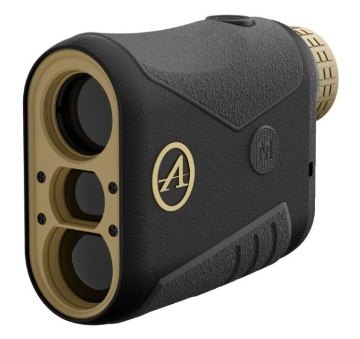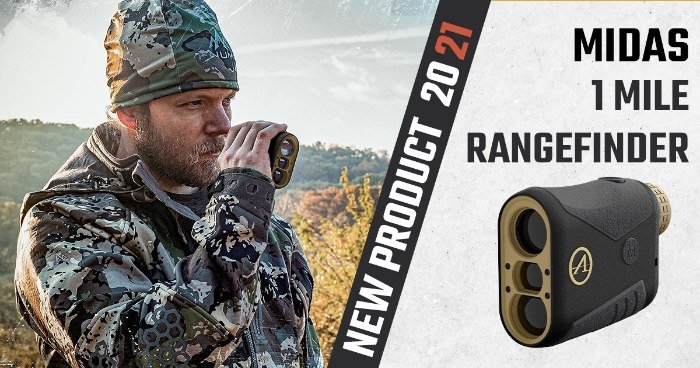Don’t you hate it when optics boast high-end performance to find out it was really just a gimmick?
Athlon doesn’t care for that kind of marketing strategy.
The Midas 1 Mile LRF brings you back down to earth with features that will meet realistic expectations.
It’s exceptionally cheaper than most rangefinders under $500, but it performs when needed.
Now that’s what really matters.
Quick Overview...
What We Like: Long-ranging
What We Don’t Like: No tripod mounting
Best Uses: Hunting, Bow Hunting, Target Shooting, Long-Range, Illumination, Angle Compensation
- Yard Range: 5-1760
- Magnification: 6x
- Objective Lens: 21mm
- Display Type: LED
- Dimensions: 3.8 x 1.4”/4.75 oz
- Waterproof/Fogproof: Yes/Yes
- Angle Compensation: Yes

Our Verdict: The Midas 1 Mile isn’t some high-tech, hard-to-use rangefinder. If anything, it takes a no-frills approach but covers all the basics with quality behind its conception. It has compactness, long-ranging, illumination, and angle compensation – anything more and it would defeat its simplistic purpose.
Who is the Athlon Midas 1 Mile Best Suited to?
The Midas 1 Mile unit is a long ranging unit as it pushes target acquisition out to 1700 yards or so. With angle compensated distances, it’s effective for both rifle and bow hunters who need a corrected distance.
Ultimately, the Midas is still a basic LRF with a couple extra perks. If you like uncluttered displays, 2-button operation with one on the side of the body, and you must have a weather-ready, compact unit, Athlon has just the rangefinder for you.
How Does the Athlon Midas 1 Mile Perform?
To prevent any confusion, the Midas 1 Mile Black/Tan #502005 is the rangefinder that is new to market and has replaced the grey model. It’s quite different from its predecessor as it features buttons in different places, has an LED display, and a new circle reticle.
It has some high-end features that includes illumination, both horizontal and vertical compensated distances, and dedicated Golf and Hunting modes.
Even so, the rangefinder remains a simple device at heart. The display provides only one measurement at a time which keeps it extremely uncluttered and easy to read. The FOV remains clear, but it introduces tedious operating steps to flip through various modes to get additional information that you may want to know.
When it comes to size and weight, it can’t be beat. It comes with a carry case that has a magnetic lid closure versus the Velcro and cord closures of other alternatives.
The Midas 1 Mile LRF isn’t the most advanced unit in the market, but it’s been upgraded to provide better functioning features that should have been a staple in the first place. We’ve got to give to Athlon for keeping up with the user demands.
Features & Benefits

Long-Ranging
It’s only been more recently that the long-ranging power of LRFs is being redefined to be well over a mile. At this price point, getting to a mile or even 2500 yards was a big deal not so long ago.
Even though we are seeing a trend of long-ranging performance encompass distances beyond 2800 yards, one mile is still a heck of a long way to go free-hand.
Ranging distances provided by Athlon is 1760 yards for reflective targets and 800 yards to deer. It’s accurate to within +/- 1-yard.
LRF Features
The Midas 1 Mile has some great highlights. One example is the LED display. The old model had an LCD display and having illumination can be essential for ranging in various conditions or for various targets.
The reticle was also changed from a cross to a circle. It’s not a dot, so the center of the reticle remains clear to prevent any obstruction of the target.
If you typically wear sunglasses or prescription glasses, you won’t be a big fan of the 14mm of eye relief. That might be a deal breaker.
But for those who have no issues with the eye relief, you can focus the display for your vision via the adjustable diopter.
The optics have FMC (Fully Multi-Coated) coatings, and it’s water-tight and nitrogen-purged for further protection from the elements.
Multiple Ranging Modes
The Midas 1 Mile is good for golf and hunting as it has dedicated modes for both sports. Essentially, you’re just moving between first and second target modes. Awesome feature.
The ranging modes are: Incline Angle, Horizontal Distance, and Vertical Distance. Incline Angle mode provides the angular measurement of an incline/decline relative to your position to +/- 70 degrees.
The Horizontal Distance mode is the equivalent horizontal distance with angle compensation relative to your position and the target.
The Vertical Distance mode is the measurement of a target’s height. You take that distance and use it with LOS measurements to acquire additional ballistic data if you’re so inclined.
What is noteworthy about the Scan mode is that you can use it in either Horizontal or Vertical distance modes from 5-1700 yards – max distance.
Extremely Simple Display
This could be both a benefit and a drawback to many. It will come down to user preference. While the Midas rangefinder has multiple ranging modes, it’s very restricting in what information will be displayed.
What we mean by this is that most rangefinders today will display the angle of the incline or decline regardless of what ranging mode you’re in. On the Midas 1 Mile, you must go into the specific ranging mode to get that data.
For example, if you want to know the incline/decline angle, you must use the menu to go into the Incline Angle (T) mode. Range the target and you’ll have the angle. Following up with that, if you want to know the compensated distance, you must go back into the menu and into Horizontal Distance (H) mode to get that measurement.
It would be an intuitive move by Athlon to provide both the angle and horizontal distance on the same display. Better yet just provide the angle whether you’re after LOS or angle compensated distances. The shooter can do what they will with the information, but this way you remove a tedious step of having to constantly shift in and out of modes.
The upside is that it keeps the display free of what can be considered unnecessary data. You just want the horizontal distance. It doesn’t matter what the angle is, you know you’ll have the compensated distance to get on point.
Limitations
No Tripod Mounting
Not having mounting points on rangefinders these days is straight-up annoying. We suppose if the entire Midas series did not have tripod compatibility, it wouldn’t be a big complaint, but it’s supposed to be an upgraded LRF line for Athlon.
What really kicks us in the rear is the Midas 1200Y has a mounting point with 6x magnification and ranges out to 1200 yards max. Why wouldn’t the 1 Mile model have this feature based on this thought process?
So, you can’t mount it for ultimate stability. It’s not a deal-breaker, but it would serve everyone better with a mounting point. Aftermarket solutions will be your only option to get it rigged up for ultimately stability.
Popular Questions
The Midas 1 Mile LRF is backed by the Athlon Gold Medal Lifetime Warranty. No purchase documents are required, and it’s covered for a lifetime.
The Midas 1 Mile features a battery life indicator icon on the display only after it detects that it has less than 2.7V of power. It will flash on the display for five seconds and then automatically power down. It’s wise to pack an extra CR2 3V battery in your gear for this very occurrence.
Yes. The Midas 1 Mile rangefinder allows you to choose measurements in either yards or meters upon setup and power on.
The Midas 1 Mile rangefinder is accurate to within +/- 1-yard. Athlon does not specify how far out it remains accurate to 1-yard (approx.).
Most would assume out to max distance, but this is rarely the case. It’s likely 1-yard to 1000 yards and then 2 yards to 1700 yards.
Conclusion
In today’s LRF market, the Midas 1 Mile almost seems unimpressive.
Let that sink in for a minute.
It shows how spoiled we are in thinking that bigger and longer is always better.
Not everyone needs ballistic solvers in their units or more information than what they can use when split seconds count.
But everyone needs quality behind a rangefinder’s basic functions.
Don’t gamble and lose. Go with what you know you need. Anything more and you may just be showing off at the risk of paying more for nothing.
Further Reading




